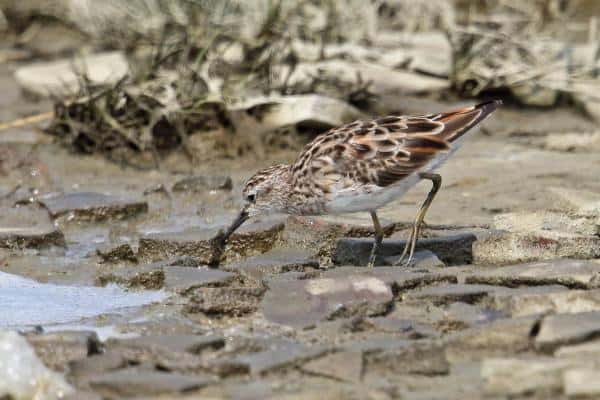Common Name: Long-toed Stint
Scientific Name: (Calidris subminuta)| Size | Diet | Range in Hawaii | Status in Hawaii |
|---|---|---|---|
| 5 in. - 6 in. | insects, crustaceans, and mollusks. | Unknown | Least Concern |
The Long-toed Stint (Calidris subminuta) is a small and elusive bird species that is known for its long toes and distinctive plumage. With its intricate markings and delicate appearance, this stint is a fascinating sight to behold in its natural habitat. Although it is not a native species to Hawaii, Long-toed Stints have been spotted occasionally on the islands as non-breeding visitors or vagrants, making for a rare and exciting sighting for birdwatchers.
In this article, we’ll explore the fascinating world of the Long-toed Stint and learn more about its unexpected presence in Hawaii.
Long-toed Stint
Appearance

The Long-toed Stint, with its petite and charming presence, captivates birdwatchers with its delicate features. Measuring approximately 5 to 6 inches in length, this diminutive shorebird embodies elegance in a compact form. Its plumage showcases a palette of soft colors that harmonize effortlessly.
The upperparts exhibit a mix of sandy browns and pale grays, adorned with intricate dark streaks that add texture to its feathers. As the name suggests, one distinct characteristic of the Long-toed Stint is its elongated toes, visible during its ventures along the water’s edge. Its slender bill, slightly curved downwards, allows it to skillfully probe the muddy substrate in search of its favorite aquatic delicacies.
During the breeding season, the Long-toed Stint dons its breeding plumage, which introduces a splash of vibrancy. The chest and belly transform into a warm and striking copper hue, effortlessly standing out among the surrounding foliage. Its eyes, accented by a subtle ring, exude an air of curiosity as it busily explores its watery habitat.
Diet
With its slender bill and elongated toes, the Long-toed Stint becomes a skilled forager. It seeks out a diverse array of delectable morsels, ranging from insects and their larvae to crustaceans and tiny mollusks.
As it tiptoes along the water’s edge, its sharp eyes keenly scan the surroundings, ever watchful for the slightest movement. It deftly plucks small aquatic insects, such as water beetles and mosquitoes, from the surface tension of the water. With a flick of its bill, it skillfully captures tiny crustaceans, like shrimp and amphipods, lurking beneath the surface.
Nesting
As the breeding season approaches, these small shorebirds embark on an arduous journey to their nesting grounds, where they create their own temporary sanctuaries. With meticulous precision, the Long-toed Stint constructs its nest on the ground, often hidden amidst the low vegetation or nestled within the shelter of grassy tufts.
The female takes the lead in nest-building, using a combination of plant materials, moss, and leaves. These carefully woven structures provide a secure foundation for the upcoming chapter of life.
Once the nest is complete, the female lays a clutch of delicately speckled eggs, usually numbering four. The eggs, with their subtle shades of cream and brown, blend harmoniously with the surrounding environment, camouflaging them from prying eyes and potential predators.
Both parents take turns incubating the eggs, diligently keeping them warm and protected. This shared responsibility allows them to alternate between guarding the nest and foraging for sustenance in nearby wetland habitats. They maintain a delicate balance between ensuring the survival of their offspring and meeting their own nutritional needs.
After a couple of weeks of attentive incubation, the eggs hatch, revealing fluffy, downy chicks. These miniature replicas of their parents quickly develop a strong bond with their caregivers, as they depend on them for nourishment and guidance in their early days of life.
Behavior

With their slender bodies and elongated toes, Long-toed Stints navigate their wetland habitats with remarkable dexterity. They gracefully tiptoe along the water’s edge, probing the muddy substrate with their bills or swiftly wading through shallow waters in search of food. Their keen eyes scan the surroundings, ever watchful for potential prey.
During the breeding season, Long-toed Stints engage in courtship rituals that involve aerial displays and vocalizations. Males perform elaborate flight patterns, fluttering their wings and producing soft, melodious calls to attract the attention of females. These captivating performances serve as a prelude to pair formation and nesting.
In terms of social dynamics, Long-toed Stints often gather in small flocks, foraging together and seeking safety in numbers. They maintain a delicate balance between competition and cooperation, vying for resources while also relying on collective vigilance against predators.
One of the most fascinating aspects of the Long-toed Stint’s behavior is its remarkable migratory journey. These birds undertake impressive long-distance flights, traveling thousands of miles across continents.
They embark on arduous migrations from their breeding grounds in northeastern Asia to their wintering grounds in Southeast Asia, Australia, and even as far as Africa. This migratory feat highlights their endurance, navigational abilities, and adaptation to changing seasons.
Habitat

Coastal regions become a favored haunt for the Long-toed Stint during their migration journeys. They grace sandy beaches, saltmarshes, and mudflats, where the interplay of land and sea creates a dynamic environment rich in food resources.
Inland marshes and wet meadows are another prime habitat for these shorebirds. They thrive in the tranquil realms of freshwater ponds, shallow lakes, and marshy expanses.
Range
The Long-toed Stint is a bird species that breeds in northeast Siberia and typically migrates to wintering grounds from eastern India to northern Australia. While they are considered rare in Hawaii, they have been observed as transients or winter visitors in the western Micronesia region.
There is a single recorded instance of a Long-toed Stint in the Northwestern Hawaiian Islands, specifically at Midway, where a first-fall female specimen was collected in August 1967. It is important to note that a reported sighting on Laysan Island, where a bird resembling a Long-toed Stint was photographed, could not be conclusively identified.
Conservation Status
The Long-toed Stint is classified as a species of “Least Concern” by the International Union for Conservation of Nature (IUCN). However, its population is believed to be in decline, and its status is closely monitored. The exact population size is challenging to estimate accurately, given its extensive breeding and wintering range.
Interesting Facts
1. Camouflaged Nests
The Long-toed Stints construct their nests using plant materials, moss, and leaves, carefully blending them with the surroundings to provide camouflage and protection for their eggs and chicks.
2. Short breeding period
The breeding season of Long-toed Stints is relatively short, typically lasting only a few weeks. This limited time frame necessitates efficient nest building, incubation, and chick rearing, emphasizing the importance of their well-adapted breeding strategies.
3. Feather preening
Long-toed Stints engage in frequent feather preening to maintain their plumage’s cleanliness and functionality. Preening involves using their beaks to arrange and clean their feathers, removing dirt, parasites, and ensuring optimal insulation and flight performance.
4. Wing shape adaptations
Long-toed Stints have evolved specialized wing shapes that enable swift and agile flight. Their long and pointed wings allow them to navigate swiftly through the air, aiding in their migratory journeys and precise movements during foraging.
5. High-frequency vocalizations
Long-toed Stints produce high-pitched and soft vocalizations, often described as a series of “twee-twee” or “weet-weet” calls. These vocalizations play a role in communication between individuals, particularly during courtship and territorial disputes.
Frequently Asked Questions
1. How far do Long-toed Stints migrate?
Long-toed Stints undertake impressive long-distance migrations, traveling thousands of miles from their breeding grounds in northeastern Asia to their wintering grounds in Southeast Asia, Australia, and even Africa. Some individuals may cover distances of up to 8,000 miles (13,000 kilometers) annually.
2. How long do Long-toed Stints live?
The lifespan of Long-toed Stints can vary, but some individuals have been known to live up to 11 years.
3. Can Long-toed Stints swim?
Long-toed Stints are not strong swimmers and typically do not swim extensively. However, they can paddle and float on the water’s surface if necessary, using their wings and feet for propulsion and balance.
4. Are Long-toed Stints diurnal or nocturnal?
Long-toed Stints are primarily diurnal birds, meaning they are active during daylight hours. They typically forage and engage in other activities during the daytime while resting or roosting at night.




